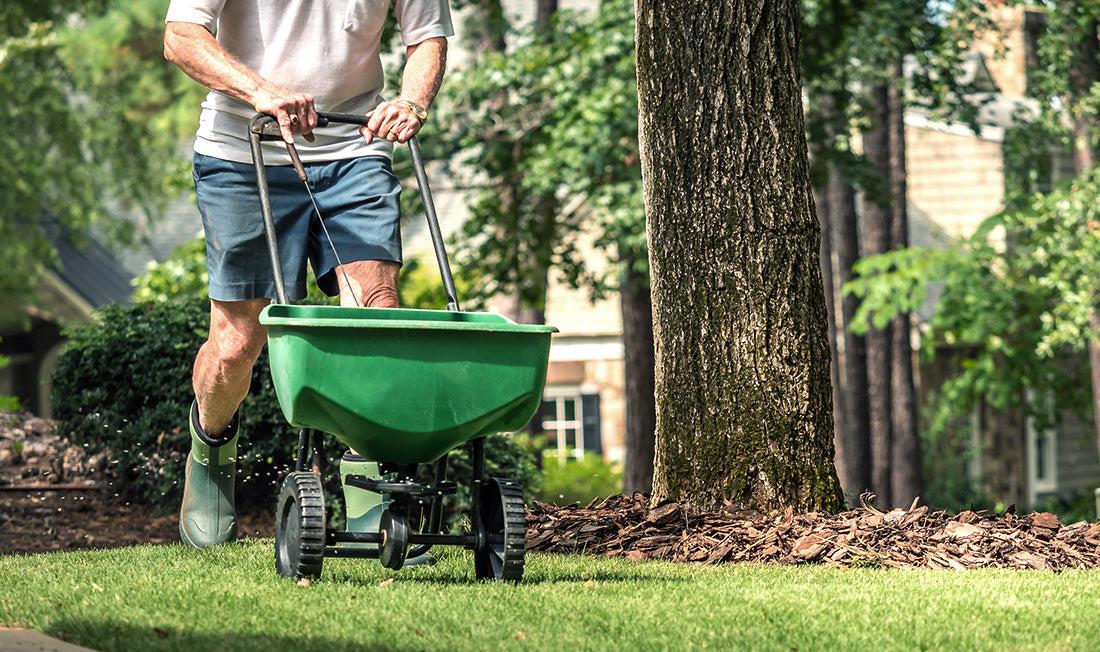Just like the dog days of summer, it feels as though we’re trekking through the monotonous tundra of wintertime. Remember that the night is always darkest before the dawn. Soon enough, we will be back out on our lawns, maintaining and enjoying our own little pieces of paradise. But in order to achieve lawn nirvana, we have to limit mistakes when choosing to fertilize our lawns. Let’s go over some common mishaps that can take place while we’re fertilizing the lawn.

Fertilizing Dormant Grass
Grasses go into dormancy as a survival mechanism. Lack of water, intense cold, and extreme heat can all send warm-season and cool-season grasses into a dormant (read: brown) state. Some dormancy can be counterintuitive. For example, warm-season grasses are dubbed as drought-tolerant grasses, which must mean they’ll be green all summer, regardless of rainfall or irrigation. This just isn’t true. Even bermudagrass has its breaking point, too little water for too long of a period during the summer, and even bermudagrass will start going brown to make sure it survives until the next meaningful volume of water enters the soil. The point in mentioning that was to provide evidence that brown grass won’t always respond to fertilizer. Rule out other sources of stress prior to reaching for the SLS 16-4-8 to perk up a brown lawn.

Applying Fertilizer in the Heat of the Day
Heat-stressed grass needs all of the help that it can get, but this shouldn’t come in the form of fertilization. When thinking of a fertilizer program, the goal should be to fertilize to set your lawn up for success to handle the heat of the day. Fertilizers contain salts in differing amounts. When applied to the turf or the soil, the salt content in the fertilizer can have a desiccating effect, drawing water from the plant rather than allowing water to travel up through the plant for transpirational cooling (how grasses can regulate their temperature). Help your grass survive the heat of the day by choosing taller mowing heights, irrigating in the morning prior to extreme heat, and irrigating deeply and infrequently. Deep, infrequent irrigation encourages deep roots, essential to get your lawn through the hottest of days. When you do choose to fertilize, try to get it out before 10 am and after 4 pm during the heat of the summer.

Not Watering your Fertilizer in
This is especially important with granular fertilizers. For example, urea, a common form of nitrogen found in fertilizers, is subject to nitrogen loss via the volatilization of ammonia. Volatilization losses can be reduced by incorporating the fertilizer into the soil as quickly as possible, typically via irrigation or applying it just before a rain event. Limiting nitrogen losses helps the nutrients you paid for do their job rather than become a victim of nitrogen loss. If you're making a liquid fertilizer application, it is probably a good idea to still water in the fertilizer sometime in the 24 hours following an application, but this isn’t 100% necessary all of the time. Some nutrients, like iron, are very effective when applied as a foliar spray rather than a soil drench, so this is an instance where watering in isn’t necessary, especially if your soil pH is upwards of 7.

Fertilizing in Winter
This is one that, dare I say, is open for interpretation. There can be quite a bit of disagreement as to the amounts and timing of the last fertilizer application for the year. Also, “late in the season” can mean different things depending on your grass type and location. Think of “late in the season” as around the time you notice that when you’re mowing, you’re not having to mow as frequently, or you’re not cutting as much of the leaf blade off as you had been in previous weeks. If your warm-season lawn has turned off color after the first frost of the year, consider it too late in the season to be applying fertilizers. If you have cool-season grass with a history of snow mold, it may be better to skip that last fertilizer app in November that could make your lawn an enticing target for wintertime fungal pathogens.

Not Applying Fertilizer to Lawn Evenly
Lawn stripes provide a beautiful aesthetic to a yard. However, we want the stripes to come from the lawn mower laying the grass blades down in different directions and not from misapplied fertilizers or pesticides. Try applying fertilizers in multiple directions to avoid skips or heavy overlaps.
Avoiding the aforementioned mistakes will have you well on your way to being the envy of the neighborhood. Let the others make the mistakes and go with Simple Lawn Solutions fertilizers this summer. Not sure what to buy? Try our lawn quiz to help narrow down our wide selection of liquid fertilizers. You can also gain a leg up on the competition by getting a personalized lawn plan from us today!









